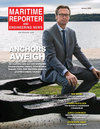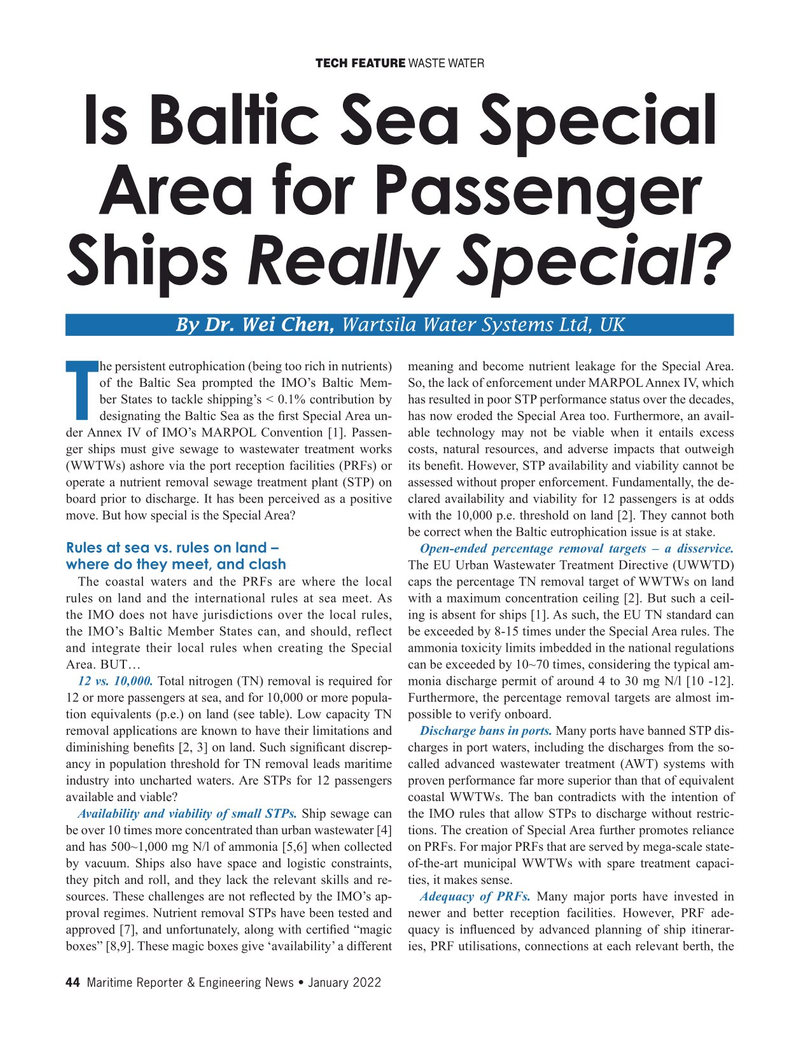
Page 44: of Maritime Reporter Magazine (January 2022)
The Ship Repair & Conversion Edition
Read this page in Pdf, Flash or Html5 edition of January 2022 Maritime Reporter Magazine
TECH FEATURE WASTE WATER
Is Baltic Sea Special
Area for Passenger
Ships Really Special?
By Dr. Wei Chen, Wartsila Water Systems Ltd, UK he persistent eutrophication (being too rich in nutrients) meaning and become nutrient leakage for the Special Area. of the Baltic Sea prompted the IMO’s Baltic Mem- So, the lack of enforcement under MARPOL Annex IV, which ber States to tackle shipping’s < 0.1% contribution by has resulted in poor STP performance status over the decades, designating the Baltic Sea as the ? rst Special Area un- has now eroded the Special Area too. Furthermore, an avail-
T der Annex IV of IMO’s MARPOL Convention [1]. Passen- able technology may not be viable when it entails excess ger ships must give sewage to wastewater treatment works costs, natural resources, and adverse impacts that outweigh (WWTWs) ashore via the port reception facilities (PRFs) or its bene? t. However, STP availability and viability cannot be operate a nutrient removal sewage treatment plant (STP) on assessed without proper enforcement. Fundamentally, the de- board prior to discharge. It has been perceived as a positive clared availability and viability for 12 passengers is at odds move. But how special is the Special Area? with the 10,000 p.e. threshold on land [2]. They cannot both be correct when the Baltic eutrophication issue is at stake.
Rules at sea vs. rules on land –
Open-ended percentage removal targets – a disservice. where do they meet, and clash
The EU Urban Wastewater Treatment Directive (UWWTD)
The coastal waters and the PRFs are where the local caps the percentage TN removal target of WWTWs on land rules on land and the international rules at sea meet. As with a maximum concentration ceiling [2]. But such a ceil- the IMO does not have jurisdictions over the local rules, ing is absent for ships [1]. As such, the EU TN standard can the IMO’s Baltic Member States can, and should, reflect be exceeded by 8-15 times under the Special Area rules. The and integrate their local rules when creating the Special ammonia toxicity limits imbedded in the national regulations
Area. BUT… can be exceeded by 10~70 times, considering the typical am- 12 vs. 10,000. Total nitrogen (TN) removal is required for monia discharge permit of around 4 to 30 mg N/l [10 -12]. 12 or more passengers at sea, and for 10,000 or more popula- Furthermore, the percentage removal targets are almost im- tion equivalents (p.e.) on land (see table). Low capacity TN possible to verify onboard.
removal applications are known to have their limitations and Discharge bans in ports. Many ports have banned STP dis- diminishing bene? ts [2, 3] on land. Such signi? cant discrep- charges in port waters, including the discharges from the so- ancy in population threshold for TN removal leads maritime called advanced wastewater treatment (AWT) systems with industry into uncharted waters. Are STPs for 12 passengers proven performance far more superior than that of equivalent available and viable? coastal WWTWs. The ban contradicts with the intention of
Availability and viability of small STPs. Ship sewage can the IMO rules that allow STPs to discharge without restric- be over 10 times more concentrated than urban wastewater [4] tions. The creation of Special Area further promotes reliance and has 500~1,000 mg N/l of ammonia [5,6] when collected on PRFs. For major PRFs that are served by mega-scale state- by vacuum. Ships also have space and logistic constraints, of-the-art municipal WWTWs with spare treatment capaci- they pitch and roll, and they lack the relevant skills and re- ties, it makes sense. sources. These challenges are not re? ected by the IMO’s ap- Adequacy of PRFs. Many major ports have invested in proval regimes. Nutrient removal STPs have been tested and newer and better reception facilities. However, PRF ade- approved [7], and unfortunately, along with certi? ed “magic quacy is in? uenced by advanced planning of ship itinerar- boxes” [8,9]. These magic boxes give ‘availability’ a different ies, PRF utilisations, connections at each relevant berth, the 44 Maritime Reporter & Engineering News • January 2022
MR #1 (34-49).indd 44 1/6/2022 10:06:52 AM

 43
43

 45
45
